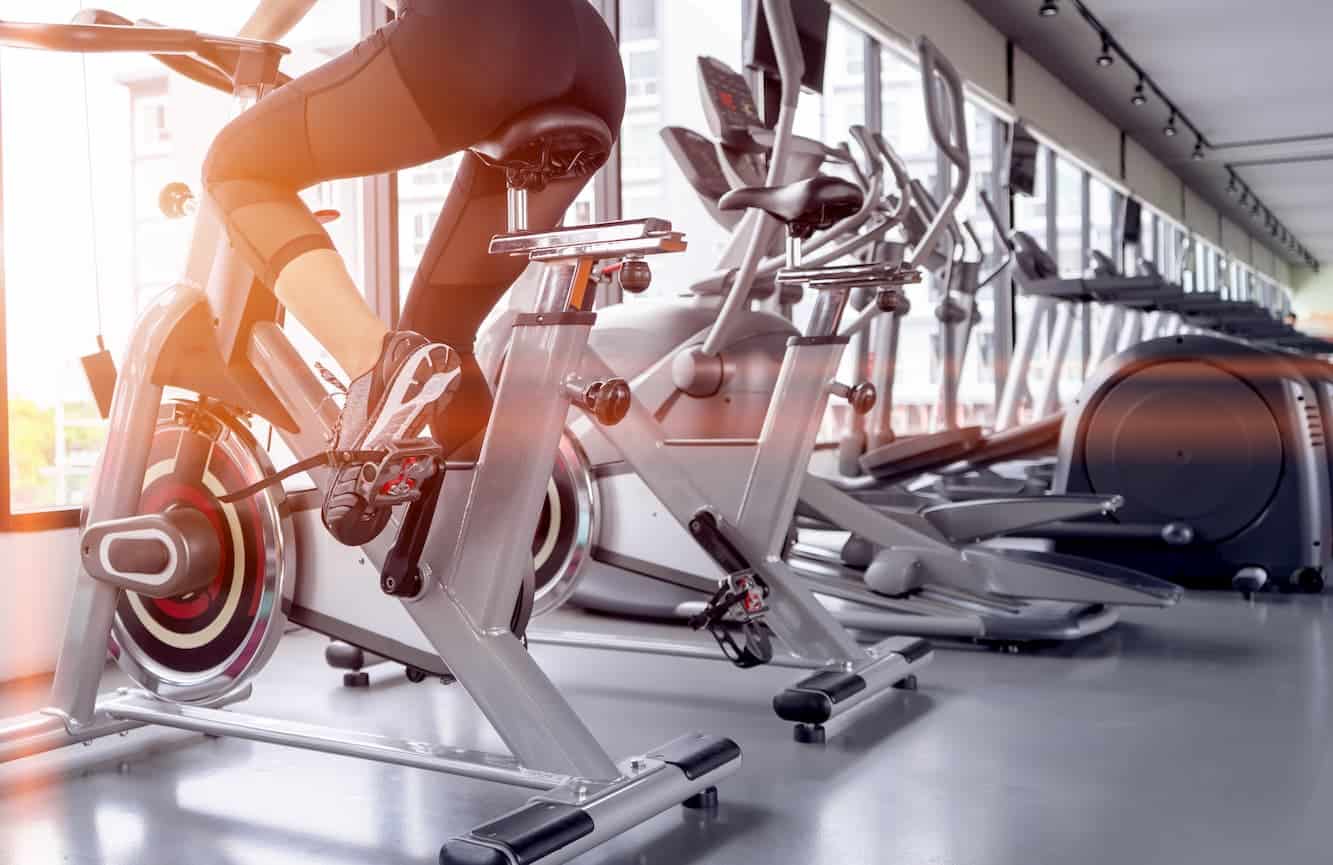When it comes to staying healthy and fit, cardio is one of the best ways to do so. It helps strengthen your heart and lungs, burns calories for weight loss, and can improve overall fitness levels. But how much is enough? How often should you be doing cardio if you want to look and feel your best?
If you’re looking for answers to these questions in pursuit of a healthier lifestyle (and who isn’t?), then this blog post is just what you need!
We’ll discuss everything from recommended frequency of exercise based on your goals or activity level, tips for getting started or upping up your sessions if needed – as well as share some fun ideas on what types of activities are considered “cardio.”
So put on those sneakers because it’s time to get moving!
Benefits Of Cardio
If you’re looking to improve your overall health and fitness, getting into a regular cardio routine is one of the best things you can do.
Cardio exercises are great for increasing your heart rate and improving your overall stamina, and they can be tailored to any skill level.
Here are some of the key benefits of doing regular cardio:
- Improved cardiovascular health: Regular cardio exercise strengthens your heart muscle, improves blood circulation throughout the body, lowers cholesterol levels, helps reduce high blood pressure, and reduces stress levels.
- Increased energy levels: Doing regular aerobic activity increases oxygen intake in the body which leads to higher endurance during physical activities. This allows for more energy throughout the day as well as better performance when exercising or playing sports.
- Weight loss/management: Aerobic activity is an effective way to burn calories and fat in order to lose weight or maintain a healthy weight range.
- Stress relief: Exercise releases endorphins in our bodies that help us feel happier and relaxed after a workout session. This also helps us sleep better at night resulting in improved mental clarity during daily activities.
Cardio Guidelines For Beginners
Starting a cardio routine can be intimidating, but it doesn’t have to be. Whether you’re just beginning or returning after some time away from the gym, here are some tips for getting started and making sure you stick with it:
- Take It Slow – Don’t jump straight into intense cardio workouts. Start off slow and increase your intensity gradually as your body gets used to the routine. This will help reduce the risk of injury and burnout.
- Listen To Your Body – Make sure that you give yourself plenty of rest days in between workouts so that your body has time to recover and build up strength for future exercises. Be aware of any pain or discomfort during exercise, as this could be a sign of overtraining or an injury waiting to happen.
- Choose Your Cardio Wisely – Not all cardio exercises are created equal! Consider what kind of physical activity you actually enjoy doing before committing to a regular routine; if running isn’t something you like doing, don’t force yourself into it! Biking, swimming, rowing, aerobics classes – there’s something out there for everyone so choose wisely!
1. Take It Slow
When embarking on a new cardio program, it’s important to take it slow and start with something manageable. For beginners, this might mean starting with just 10-15 minutes of walking or light jogging.
It’s important to listen to your body and pay attention to how you feel during the activity; if you’re feeling winded after only a few minutes, then take a break and ease off! Even for more experienced athletes, too much too soon can lead to injury or burnout.
It’s also important to choose the right type of activity for your level. For example, running may be an excellent form of cardio but if you are just starting out it may be better to stick with something low-impact such as biking or swimming until you build up strength and stamina.
The goal is always progress – not perfection!
2. Listen To Your Body
When doing cardio, it’s important to listen to your body. If you find yourself tiring out too quickly or feeling uncomfortable, then chances are that you’re pushing yourself too hard.
This is especially true if you’re just starting out. To avoid injury and burnout, take regular breaks and don’t push yourself past your limits.
The same holds true for more experienced exercisers as well. Even advanced levels should pause when needed or slow down the intensity of their workout. Staying in tune with how your body feels can prevent overexertion or injury that could derail your progress altogether.
Additionally, keep an eye out for any unusual pain while doing cardio exercises—sudden sharp pains could be signs of a serious condition that requires medical attention.
It’s better to be safe than sorry so make sure to pay attention to what your body is trying to tell you!
3. Choose Your Cardio Wisely
No matter what your level of fitness is it’s important to choose the right type and intensity of cardio for you. It can be tempting to jump straight into an intense HIIT routine, but if you’re new to cardio then this could lead to injury or burnout.
For beginners, low-impact activities such as walking or swimming are ideal as they provide a wide range of motion without putting too much strain on your joints. You should also focus on building up stamina over time rather than pushing yourself too hard in the beginning.
Intermediate levels should focus on alternating between different types of cardio workouts such as running, cycling, and rowing in order to challenge their bodies further.
You should also aim to increase the intensity gradually and keep track of your progress so that you’re challenging yourself enough without going overboard.
Advanced athletes can take their cardio routines up a notch by incorporating High Intensity Interval Training (HIIT) into their workout schedule.
HIIT involves short bursts of intense exercise followed by periods of rest which helps maximize calorie burn while improving cardiovascular endurance.
As with any exercise program, it’s important to make sure that you’re focusing on quality rather than quantity when it comes to HIIT workouts because your form is key when performing these exercises!
Cardio Guidelines For Intermediate Levels
Congratulations on reaching the intermediate level of cardio! As you progress in your fitness level, it’s important to keep challenging yourself and stay motivated.
When doing cardio at an intermediate level, there are a few things to consider:
- Increase Intensity Gradually: When increasing intensity, do so gradually and at a rate that is comfortable for you. This will help prevent injuries while still allowing for progress in your fitness goals.
- Start with an activity that is below your current level of fitness and work up from there. Increase intensity or difficulty every two weeks until you reach your desired goal.
- Alternate Cardio Types: Alternating between different types of cardio can be beneficial as well as fun! This includes activities such as spinning classes, boxing, dancing, running/jogging or jumping rope. Doing this will not only help increase endurance but also strengthen the muscles used during these activities.
- Increase Frequency: To continue improving your overall health and fitness levels it is important to make sure you’re doing enough cardio each week. For most people this should be around 3-5 times per week for 30 minutes each session (dependent on individual goals).
It’s important to listen to your body when engaging in any type of physical activity – if something doesn’t feel right then take a break before continuing or seek medical advice if necessary!
1. Increase Intensity Gradually
As you start getting comfortable with your cardio routine, it’s time to increase the intensity gradually. This way, your body can slowly become used to the increased demands, and you’ll be less likely to suffer from an injury or fatigue.
Start by increasing the speed or duration of your chosen activity for a few weeks before attempting anything more challenging. For example, if you’re running on a treadmill, increase the speed by 0.5mph every two weeks until you get to where you want to be.
When it comes to weightlifting, use heavier weights as long as they do not put too much strain on your muscles and joints. Start with low weights and increase them gradually over time so that your body adapts accordingly.
Additionally, aim for more repetitions rather than lifting heavy weights all at once – this will help build endurance without risking injury or overexertion of any particular muscle group.
Finally, be aware of how often you are doing cardio workouts each week – too much exercise can lead to burnout quickly!
Aim for 3-4 days per week at most and take rest days in between workouts so that your body has time to recuperate from intensive workout sessions.
2. Alternate Cardio Types
Once you’re at an intermediate level, it’s important to alternate between different types of cardio exercises.
This will not only provide a variety of challenges and keep workouts interesting but will also help ensure that your body is being worked in the best way possible.
For example, if you normally run on the treadmill, try adding some swimming or cycling into your routine.
Mixing up your cardio routine has other benefits too – since different exercises target different muscle groups and vary in intensity levels, they can be used to target specific areas where you want to see improvements.
Alternating between lower-intensity workouts such as walking or swimming and higher-intensity ones like running or HIIT (high intensity interval training) can also help with recovery if done correctly.
Finally, it’s important to remember that no matter what kind of workout you do, it should always be tailored specifically to your goals and abilities.
If something doesn’t feel right or isn’t working for you – don’t be afraid to switch things up!
3. Increase Frequency
Once you’ve reached the intermediate level of cardio, it’s time to start increasing your frequency. How often you should do cardio will depend on your individual fitness goals and what type of exercise you are doing.
For instance, while some may find that running on a treadmill three times a week is enough for them to reach their desired weight loss goals, others may need to increase this frequency in order to see results.
When determining how often you should do cardio, it’s important to consider both intensity and duration. If each session is short but intense, then you won’t need as many sessions per week as someone who does longer but less intense workouts.
Additionally, if your goal is more focused on muscular endurance or aerobic capacity rather than weight loss then more frequent sessions are usually recommended.
It’s important that when increasing the amount of cardio in your weekly routine that you listen to what your body needs – rest periods are key!
Make sure that all sessions don’t follow one another too closely; otherwise your body won’t have enough time between activities for proper recovery.
Finally, make sure not to go overboard with how much cardio you’re doing – keep track of how long each session lasts and always give yourself plenty of days off from high intensity work-outs so that your body can properly recover!
Cardio Guidelines For Advanced Levels
Advanced level cardio requires a certain set of guidelines to get the most out of it. Here are some tips for advanced cardio training:
1. Keep Track Of Your Progress – It’s important to keep track of your progress as you move forward with your cardio routine so that you can adjust as needed.
This could mean tracking your heart rate, speed, and mileage using a fitness app or recording each session in a journal or spreadsheet.
2. Do High Intensity Interval Training (HIIT) – HIIT is an excellent way to mix up your routine and give yourself short bursts of intense activity followed by rest periods.
You can use HIIT to target specific areas like sprints or hills for added challenge and variety.
3. Focus On Quality – While logging miles is good, it is also important to focus on quality rather than quantity when it comes to advanced level cardio workouts so that you don’t overdo it and risk injury or burnout.
Make sure you have enough recovery time between sessions and take care of any injuries if they arise quickly so that you can continue training effectively without putting yourself at risk.
1. Keep Track Of Your Progress
The best way to make sure you are getting the most out of your cardio workouts is to keep track of your progress. That way, you can see if what you’re doing is actually helping you reach your goals or if there are areas that need improvement.
There are several ways to do this. You can log your workouts in a journal and track how long it takes for you to complete each exercise, the intensity level, and how often you do each one. Or use an app like Strava to measure distance and running speed or Heart Rate Monitor (HRM) apps such as MyFitnessPal that will measure heart rate throughout the workout.
Tracking also includes taking notes on how you feel during the workout—if something felt particularly challenging or easy, what inspired or motivated you during that session?
It’s important to be honest with yourself so that when it comes time for review periods, there won’t be any surprises!
Additionally, tracking helps inform future decisions about increasing/decreasing intensity levels at different points in time – this could mean adding more rest days between sessions if needed or trying a new type of exercise altogether!
Another great way to monitor progress is by taking pictures throughout your journey—these photos will provide visual evidence of improvements made over time and should help boost self-confidence as well!
Along with tracking all these things, don’t forget about regularly reevaluating goals and adjusting them accordingly; this might mean changing anything from frequency of workouts all the way up to total weight loss/gain targets.
With consistent monitoring and regular adjustments being made based on feedback provided via tracking tools, success can be achieved much faster than expected!
2. Do High Intensity Interval Training
High intensity interval training (HIIT) is a great way to take your cardio workout up a notch. It involves alternating between periods of intense exercise and short recovery periods, allowing you to push yourself harder than with traditional cardio workouts.
This type of training has been found to be especially beneficial for those looking to boost their metabolism, burn fat, and increase their aerobic and anaerobic capacity.
When doing HIIT, it’s best to start off slow and focus on form while gradually increasing the intensity as you go.
Try focusing on exercises that target multiple muscle groups at once such as squats, burpees, mountain climbers, or sprints.
Aim for sets of 30 seconds followed by 15-30 seconds of rest in between each set.
As you gain more endurance over time, consider increasing the length of the intervals or adding a few extra sets in order to further challenge yourself!
It’s also important not to overdo it when implementing HIIT into your routine since this type of exercise can produce a substantial amount of stress on your body if done too frequently or with too much intensity.
So make sure that you are properly warming up before these high-intensity intervals and listening to your body so you don’t risk injuring yourself in the process!
3. Focus On Quality
Once you’ve reached the advanced level of cardio, it’s important to focus on quality over quantity. That means that rather than just doing more and more intense workouts, you should prioritize short but effective workouts that target specific areas.
For example, if you’re looking to build strength and endurance in your legs, it might be better to do a 20 minute HIIT workout than an hour-long steady jog.
The key is to find the right balance between intensity and recovery so that your body can repair itself after each workout session without being overly fatigued.
Another way to ensure quality is by tracking your progress over time using metrics such as distance or speed. This will help you adjust your routine accordingly if needed and also give you an idea about how far along you are with achieving your goals.
Finally, make sure to always warm up before any kind of exercise as this helps prepare your muscles for the upcoming activity and prevents injury in the long run.
Warming up also helps get rid of any stiffness or pain from previous sessions so that every workout feels fresh and energizing!
Conclusion
Cardio is an important part of any fitness routine, and it’s important to understand how often you should do cardio for different levels of experience.
For beginners, it’s best to start slow and listen to your body so that you don’t overwork yourself. Choose your type of cardio wisely and make sure you take rest when needed.
For intermediate level athletes, gradually increase the intensity while alternating between types of cardio exercises. Frequency should also be increased as your body begins to adapt.
Advanced level athletes need to track their progress in order to challenge themselves further and reach new goals.
High Intensity Interval Training is a great way for experienced athletes to push their limits while focusing on quality over quantity in all forms of exercise.






Leave a Reply